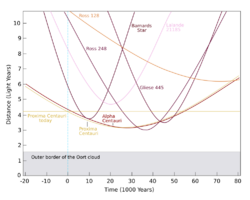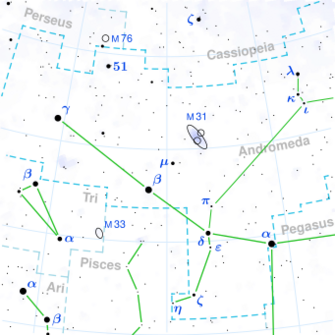Astronomy:Ross 248
Coordinates: ![]() 23h 41m 55.0361s, +44° 10′ 38.825″
23h 41m 55.0361s, +44° 10′ 38.825″
Location of Ross 248 in the constellation Andromeda | |
| Observation data Equinox J2000.0]] (ICRS) | |
|---|---|
| Constellation | Andromeda |
| Right ascension | 23h 41m 55.03630s[1] |
| Declination | +44° 10′ 38.8189″[1] |
| Apparent magnitude (V) | 12.23 - 12.34[2] |
| Characteristics | |
| Spectral type | M6 V[3] |
| U−B color index | +1.48[citation needed] |
| B−V color index | +1.92[citation needed] |
| Variable type | BY Dra[2] |
| Astrometry | |
| Radial velocity (Rv) | −77.29±0.19[1] km/s |
| Proper motion (μ) | RA: 112.527±0.036[1] mas/yr Dec.: −1591.650±0.027[1] mas/yr |
| Parallax (π) | 316.4812 ± 0.0444[1] mas |
| Distance | 10.306 ± 0.001 ly (3.1597 ± 0.0004 pc) |
| Absolute magnitude (MV) | 14.79[4] |
| Details | |
| Mass | 0.145[5] M☉ |
| Radius | 0.190[5] R☉ |
| Luminosity | 0.0022[6] L☉ |
| Surface gravity (log g) | 5.13[6] cgs |
| Temperature | 2,930[5] K |
| Metallicity [Fe/H] | +0.23[5] dex |
| Rotation | 99.58 d[7] |
| Rotational velocity (v sin i) | 0.1[7] km/s |
| Age | 2.6[5] Gyr |
| Other designations | |
| Database references | |
| SIMBAD | data |
Ross 248, also called HH Andromedae or Gliese 905, is a small star approximately 10.30 light-years (3.16 parsecs)[9] from Earth in the northern constellation of Andromeda. Despite its proximity it is too dim to be seen with the naked eye.[10] It was first catalogued by Frank Elmore Ross in 1926 with his second list of proper-motion stars;[11] on which count it ranks 261st in the SIMBAD database. It was too dim to be included in the Hipparcos survey. In about 40,000 years, Voyager 2 will pass 1.7 light-years (9.7 trillion miles) from the star.
Within the next 80,000 years, Ross 248 is predicted to be the nearest star to the Sun for around 9,000 years, overtaking the current nearest star, the triple system Alpha Centauri.
Characteristics

This star has about 14% of the Sun's mass and 19% of the Sun's radius, but only 0.2% of the Sun's luminosity. It has a stellar classification of M6 V,[3] which indicates it is a type of main-sequence star known as a red dwarf. This is a chromospherically-active star.[13] With high probability, there appears to be a long-term cycle of variability with a period of 4.2 years. This variability causes the star to range in visual magnitude from 12.23 to 12.34.[12] In 1950, this became the first star to have a small variation in magnitude attributed to spots on its photosphere as it rotates,[14] a class known as BY Draconis variables.[2]
Examining the proper motion of Ross 248 has found no evidence of a brown dwarf or stellar companion orbiting between 100–1400 AU,[15] and other unsuccessful searches have been attempted using both the Hubble Space Telescope Wide Field Planetary Camera[4] and by near-infrared speckle interferometry.[16] Long-term observations by the Sproul Observatory show no astrometric perturbations by any unseen companion.[14]
Distance from the Sun

The space velocity components of this star in the galactic coordinate system are [U, V, W] = [−32.9±0.7, −74.3±1.3, 0.0±1.4] km/s.[9] The trajectory of Ross 248 will bring it closer to the Solar System. In 1993, Matthews projected that in about 33,000 years it would enter a period of about 9,000 years as the closest star to the Sun, as close as 3.024 light-years (0.927 parsecs) in 36,000 years.[17]
Any future spacecraft that escaped the Solar System with a velocity of 25.4 km/s would reach this star 37,000 years from now, when the star just passes its nearest approach. By comparison, the Voyager 1 has an escape velocity of 16.6 km/s.[18]
The closest stellar neighbors to Ross 248 are Groombridge 34, at 1.8 light-years away, and Kruger 60, at 4.5 light-years.[19]
See also
References
- ↑ 1.0 1.1 1.2 1.3 1.4 Vallenari, A. et al. (2022). "Gaia Data Release 3. Summary of the content and survey properties". Astronomy & Astrophysics. doi:10.1051/0004-6361/202243940 Gaia DR3 record for this source at VizieR.
- ↑ 2.0 2.1 2.2 Samus, N. N. et al. (2009). "VizieR Online Data Catalog: General Catalogue of Variable Stars (Samus+ 2007-2013)". VizieR On-line Data Catalog: B/GCVS. Originally Published in: 2009yCat....102025S 1: B/gcvs. Bibcode: 2009yCat....102025S.
- ↑ 3.0 3.1 Jenkins, J. S.; Ramsey, L. W.; Jones, H. R. A.; Pavlenko, Y.; Gallardo, J.; Barnes, J. R.; Pinfield, D. J. (October 2009). "Rotational Velocities for M Dwarfs". The Astrophysical Journal 704 (2): 975–988. doi:10.1088/0004-637X/704/2/975. Bibcode: 2009ApJ...704..975J.
- ↑ 4.0 4.1 Schroeder, Daniel J. et al. (2000). "A Search for Faint Companions to Nearby Stars Using the Wide Field Planetary Camera 2". The Astronomical Journal 119 (2): 906–922. doi:10.1086/301227. Bibcode: 2000AJ....119..906S.
- ↑ 5.0 5.1 5.2 5.3 5.4 Mann, Andrew W. et al. (May 2015). "How to Constrain Your M Dwarf: Measuring Effective Temperature, Bolometric Luminosity, Mass, and Radius". The Astrophysical Journal 804 (1): 38. doi:10.1088/0004-637X/804/1/64. 64. Bibcode: 2015ApJ...804...64M.
- ↑ 6.0 6.1 Schweitzer, A. et al. (2019). "The CARMENES search for exoplanets around M dwarfs. Different roads to radii and masses of the target stars". Astronomy and Astrophysics 625: 625. doi:10.1051/0004-6361/201834965. Bibcode: 2019A&A...625A..68S.
- ↑ 7.0 7.1 Newton, Elisabeth R.; Irwin, Jonathan; Charbonneau, David; Berta-Thompson, Zachory K.; Dittmann, Jason A.; West, Andrew A. (2016). "The Rotation and Galactic Kinematics of Mid M Dwarfs in the Solar Neighborhood". The Astrophysical Journal 821 (2): 93. doi:10.3847/0004-637X/821/2/93. Bibcode: 2016ApJ...821...93N.
- ↑ "V* HH And". SIMBAD. Centre de données astronomiques de Strasbourg. http://simbad.u-strasbg.fr/simbad/sim-basic?Ident=V%2A+HH+And.
- ↑ 9.0 9.1 Leggett, S. K. (September 1992). "Infrared colors of low-mass stars". Astrophysical Journal Supplement Series 82 (1): 351–394. doi:10.1086/191720. Bibcode: 1992ApJS...82..351L.
- ↑ Routray, Sudhir K. (2004). Light Years Away: The Whole Creation at a Glance. iUniverse. p. 31. ISBN 0-595-33582-9. https://books.google.com/books?id=BES00I8VayEC&pg=PA31.
- ↑ Ross, Frank E. (February 1926). "New proper-motion stars, (second list)". Astronomical Journal 36 (856): 124–128. doi:10.1086/104699. Bibcode: 1926AJ.....36..124R.
- ↑ 12.0 12.1 Weis, Edward W. (March 1994). "Long term variability in dwarf M stars". Astronomical Journal 107 (3): 1135–1140. doi:10.1086/116925. Bibcode: 1994AJ....107.1135W.
- ↑ Poveda, Arcadio; Allen, Christine; Herrera, Miguel Angel (1996). "Chromospheric Activity, Stellar Winds and Red Stragglers". 5. Universidad Nacional Autonoma de Mexico. pp. 16–20. Bibcode: 1996RMxAC...5...16P.
- ↑ 14.0 14.1 Lippincott, S. L. (July 1978). "Astrometric search for unseen stellar and sub-stellar companions to nearby stars and the possibility of their detection". Space Science Reviews 22 (2): 153–189. doi:10.1007/BF00212072. Bibcode: 1978SSRv...22..153L.
- ↑ Hinz, Joannah L. et al. (February 2002). "A Near-Infrared, Wide-Field, Proper-Motion Search for Brown Dwarfs". The Astronomical Journal 123 (4): 2027–2032. doi:10.1086/339555. Bibcode: 2002AJ....123.2027H.
- ↑ Leinert, C.; Henry, T.; Glindemann, A.; McCarthy, D. W. Jr. (September 1997). "A search for companions to nearby southern M dwarfs with near-infrared speckle interferometry". Astronomy and Astrophysics 325: 159–166. Bibcode: 1997A&A...325..159L.
- ↑ Matthews, R. A. J. (Spring 1994). "The Close Approach of Stars in the Solar Neighborhood". Quarterly Journal of the Royal Astronomical Society 35 (1): 1. Bibcode: 1994QJRAS..35....1M.
- ↑ West, F. R. (March 1985). "A Suggested Future Space Mission to the Low-Luminosity Star Ross 248=Gliese 905". Bulletin of the American Astronomical Society 17: 552. Bibcode: 1985BAAS...17..552W.
- ↑ "Ross 248". Sol Station. http://www.solstation.com/stars/ross248.htm.
Sources
- Riaz, Basmah; Gizis, John E.; Harvin, James (2006). "Identification of New M Dwarfs in the Solar Neighborhood". The Astronomical Journal 132 (2): 866–872. doi:10.1086/505632. Bibcode: 2006AJ....132..866R. Table 1.
- Dittmann, Jason A.; Irwin, Jonathan M.; Charbonneau, David; Berta-Thompson, Zachory K. (2014). "Trigonometric Parallaxes for 1507 Nearby Mid-to-late M Dwarfs". The Astrophysical Journal 784 (2): 156. doi:10.1088/0004-637X/784/2/156. Bibcode: 2014ApJ...784..156D. Table with parallaxes.
External links
- "Ross 248". Sol Station. http://www.solstation.com/stars/ross248.htm.
- SolStation.com: Ross 248
- Image HH Andromedae
 |


